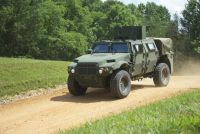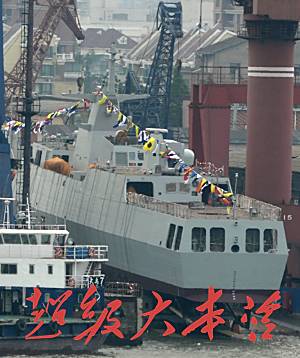CHURCHVILLE TEST AREA, Md. — The Army is testing a new vehicle looking to eventually replace the iconic Humvee. Officials said the Joint Light Tactical Vehicle will offer increased protection and performance.
The Army took a group of reporters to a dirt test track about 30 minutes from Aberdeen Proving Ground June 3 to put the new vehicles through their paces. At first glance, the JLTV looks heavier and safer than current light tactical vehicles. The armor plating and bullet-proof glass will offer better protection for the warfighter, officials said.
The vehicle has different configurations, which seat four to six people.
The JLTV project is a joint project, but also international. The vehicle is a collaborative product between the U.S. Marine Corps, the U.S. Army, the Australian government and three American industry teams.
“There are three contractor teams working on a common phased set of requirements,” said U.S. Army Lt. Col. Wolfgang Petermann, project manager. “The vehicles have a little bit different design solutions built into them.”
Petermann said the contractors delivered the vehicles on schedule and within cost requirements of the contract.
“What you’ll see is a balanced solution,” he said. “The key attributes for JLTV are to keep that balance, but also to reduce life-cycle costs for the services. We’ve improved reliability, maintainability. We’ve designed the vehicle to be, one, reliable, but when it does break down, it is easily repairable.”
Petermann said another requirement is transportability.
“We need to be able to get to the fight by a C‑130 (airplane) or CH-47 or CH-53 helicopter. We have to be able to get down to different decks on shipping,” he said. “We have maintained an expeditionary capability for the services.”
The contractors for the project are BAE Systems, General Tactical Vehicles and Lockheed Martin. During the 15-month design and build phase, industry teams interpreted military’s requirements to come up with their own vehicle prototypes. Officials said the design and build phase ended May 3 when the contractors delivered the vehicles.
The JLTV has now entered a technology development phase giving the team an opportunity to demonstrate “mature technologies integration” as a complete system.
Petermann said the group will conduct performance tests on the vehicles at Aberdeen Proving Ground to “provide an assessment of the technical and performance risks.”
The team will also conduct tests at Yuma Proving Ground, Ariz., to assess vehicle reliability.
United States Army Research, Development and Engineering Command tank and automotive engineers from the unit’s research center near Detroit have been on the job from concept to testing. The Tank Automotive Research, Development and Engineering Center assists throughout product development, officials said.
“Our Advanced Concepts Group over in TARDEC from the beginning has taken a look at our requirements from the standpoint of what is achievable,” said Chris Brouwer, C4I chief systems engineer with the project. “They’ve given us that first look on what they think we’re going to get with the requirements we have. Because of the work TARDEC did, we were fairly confident what we would end up with.”
When the project team had requirements changes, TARDEC engineers would update their concepts.
“They would say, ‘this is what we think industry is going to provide you,’ ” he said. “It really gave us an early benefit as far as what our requirements were actually driving into the design of the vehicle.”
Brouwer was on the team three years ago writing the original requirements and scope.
“It’s been a great project so far,” Brouwer said. “It’s very rewarding to see the vehicles out here on the track and performing quite well.”
(Editor’s note: The JLTV program is aligned with a joint program office under the management of the U.S. Army’s Project Manager for Joint Combat Support Systems, which fulls under the leadership of Program Executive Officer for Combat Support and Combat Service Support.)
Source:
David McNally (Research, Development and Engineering Command Public Affairs)
U.S. Department of Defense
Office of the Assistant Secretary of Defense (Public Affairs)

 von
von 
